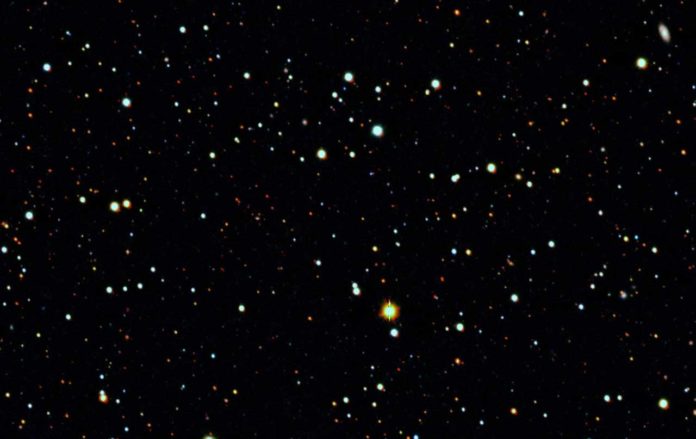Tucana II is an ultrafaint dwarf galaxy with about 50 kiloparsecs, or 163,000 light-years, from Earth. It is one of the most primitive dwarf galaxies known, based on its stars’ metal content.
Previously, astronomers identified a handful of stars around the galaxy’s core with such low metal content. Also, it was also wondered whether the ancient galaxy might harbor other, even older stars, that might shed light on the formation of the universe’s first galaxies.
To test these ideas, astronomers obtained observations of Tucana II through the SkyMapper Telescope. The observations revealed stars at the edge of Tucana II, in a configuration that is surprisingly far from its center but caught up in the tiny galaxy’s gravitational pull.
This is the first evidence that Tucana II hosts an extended dark matter halo. The discovery of stars at the galaxy’s edge indicates that the earliest galaxies in the universe were also likely extended and more massive than previously thought.
MIT graduate student Anirudh Chiti said, “Tucana II has a lot more mass than we thought, to bound these stars that are so far away. This means that other relic first galaxies probably have these kinds of extended halos too.”
The observations also revealed that the stars are more primitive than the stars at the galaxy’s core. This is the first evidence of such a stellar imbalance in an ultrafaint dwarf galaxy.
The unique configuration proposes that the galaxy might result from one of the first mergers in the universe.
Using an imaging filter on the SkyMapper Telescope, astronomers spotted primitive, metal-poor stars beyond the galaxy’s core. They ran the algorithm through the filtered data to efficiently pick out stars with low metal content, including the previously identified stars at the center and nine new stars much further out from the galactic core.
The analysis shows a kinematic connection, that these far-out stars move in lockstep with the inner stars, like bathwater going down the drain.
Based on these results, scientists concluded that the Tucana II must have extended dark matter halo, three to five times more massive than previously thought.
MIT graduate student Anirudh Chiti said, “Without dark matter, galaxies would fly apart. It is a crucial ingredient in making a galaxy and holding it together.”
Anna Frebel, the Silverman Family Career Development Associate Professor of Physics at MIT, said, “This probably also means that the earliest galaxies formed in much larger dark matter halos than previously thought. We have thought that the first galaxies were the tiniest, wimpiest galaxies. But they actually may have been several times larger than we thought, and not so tiny after all.”
Further observations were taken from Magellan Telescopes in Chile. With Magellan, the team focused on the galaxy’s metal-poor stars to derive their relative metallicities and discovered the outer stars were three times more metal-poor, and therefore more primitive, than those at the center.
Chiti said, “This is the first time we’ve seen something that looks like a chemical difference between the inner and outer stars in an ancient galaxy.”
Frebel says, “The Milky Way, no mercy will eventually eat Tucana II. And it turns out this ancient galaxy may have its cannibalistic history.”
The team plans to use their approach to observe other ultrafaint dwarf galaxies around the Milky Way in hopes of discovering even older, farther-flung stars.
This research was supported, in part, by NASA and the National Science Foundation.
Journal Reference:
- Chiti, A., Frebel, A., Simon, J.D., et al. An extended halo around an ancient dwarf galaxy. Nat Astron (2021). DOI: 10.1038/s41550-020-01285-w
